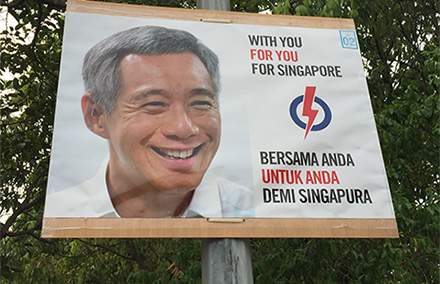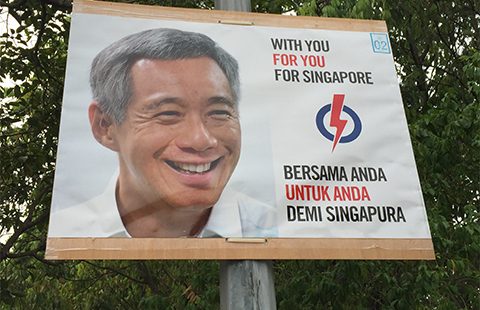
Prime Minister Lee Hsien Loong had led PAP to a sweeping election win. Photo: Jack Wikipedia on flickr https://www.flickr.com/photos/jack_tt_lee/
Why we shouldn’t be surprised by Singapore’s 2015 election results.
With the People’s Action Party (PAP) winning 83 out of 89 seats in Singapore’s elections, and the Workers’ Party (WP) losing one seat gained in the 2013 by-election, many observers seem to be surprised by the continuation of the long-time rulers’ dominance.
Despite the hype about Singapore’s ever-strengthening opposition parties during the campaign period, if we consider the broader nature of Singapore’s political institutions and development, we should not be surprised by the results.
Arguably, the key features of Singapore’s institutions and political development have not fundamentally changed in such a way that we should expect weakening electoral support for PAP and its dominance in parliament. This is especially true when considering how votes get translated to legislative seats in Singapore, which in turn directly translates to government formation in a parliamentary system.
First, Singapore uses the first-past-the-post (FPTP) system that is known to be disadvantageous to smaller parties.
Unlike the proportional representation (PR) system where 40 per cent of votes will translate to roughly 40 per cent of seats gained, FPTP means that the only way a party could gain any seat is by winning more 50 per cent of votes in a district if only two parties are competing.
To make matters even worse for the opposition, many electoral districts are multi-member districts with ethnic quotas (Group Representation Constituency). This means that the winner gets to take all of the seats in the district (as many as four to six). With around 12 per cent of national popular votes, WP only gets 6.7 per cent of representation in parliament, for instance.
Second, since Singapore is a parliamentary system, PAP is the only party ever in power, and it dominates the parliament.
Consequently, PAP gets a lot of discretion to redraw electoral districts’ boundaries; decide on a snap election timing, and campaign length; and formulate electoral rules. New districts, a relatively sudden election, a short campaign period and the inflexibility to place candidates due to ethnic restrictions in GRCs, mean the opposition did not have much time or space to coordinate within and across parties, leading to suboptimal multi-cornered fights in constituencies.
Not only that, the opposition had to face the most successful single-party incumbent in the world, as well as fight against each other on a similar platform. At MacPherson Single Member Constituency for example, WP has to face PAP and another opposition party, the National Solidarity Party.
Third, PAP’s reign as a super-incumbent affects the political culture and attitude of voters.
PAP not only has ruled since Singapore’s independence, it has also provided high-levels of economic development and stability to Singaporeans. Voters who have never experienced a different government make-up could be very wary about the prospect of a slight change in government, possibly because they are not used to dealing with how political uncertainty could affect their wellbeing.
Fourth, PAP perfectly understands its advantageous position as a super-incumbent and picked the best electoral timing possible.
This year marks Singapore’s 50th anniversary of independence, also celebrating many development milestones, which the PAP can rightly exploit. Additionally, this is also the year of the late Prime Minister Lee Kuan Yew’s passing and he was the man behind Singapore’s development.
These two events invoked heavy retrospective voting among voters which went beyond a normal business or electoral cycle. Rather than asking themselves the usual economic voting question–am I or is Singapore better off now than in 2011–voters might ask am I or is Singapore better of now than when PAP first came to power?
Knowing all these things, the 2015 election result does not look at all different from past election results.
The only slightly diverging electoral result was in 2011 when PAP only won 81 out of 87 seats, which was probably because it was the party’s first time dealing with significant online and digital campaigns.
It is therefore interesting that both local and international observers were led to believe that there would be a drastic change this election.
We might speculate whether the portrayal of a “freak election” was an intentional electoral strategy to exploit voters’ risk aversion.
Unless there are fundamental changes outlined above, we should not expect PAP’s regime survival and dominance to be seriously threatened.
Jennifer Frentasia is a PhD student at University of Michigan researching comparative election, parties, and democratisation especially in Southeast Asia and new democracies.
 Facebook
Facebook  Twitter
Twitter  Soundcloud
Soundcloud  Youtube
Youtube  Rss
Rss 